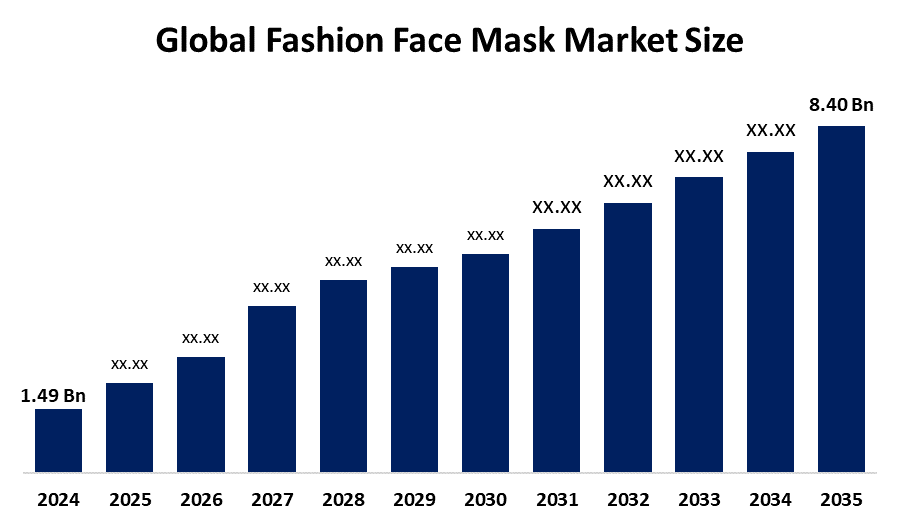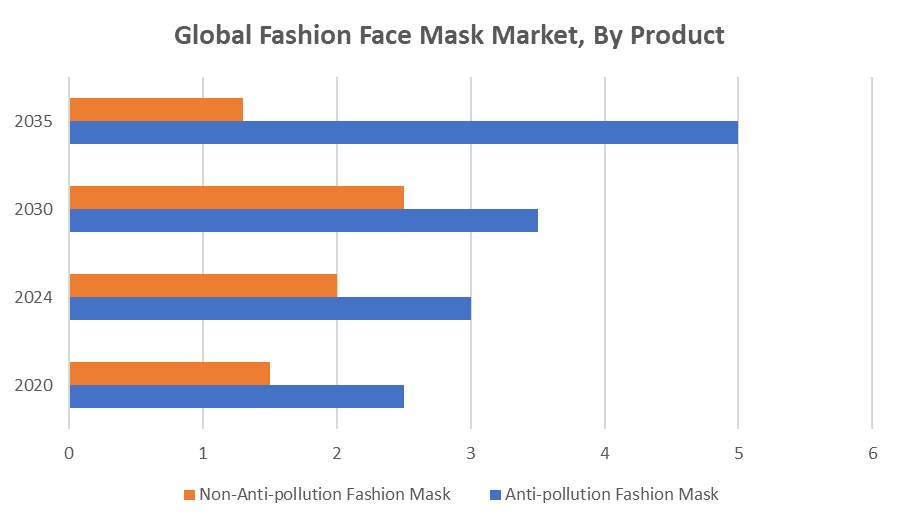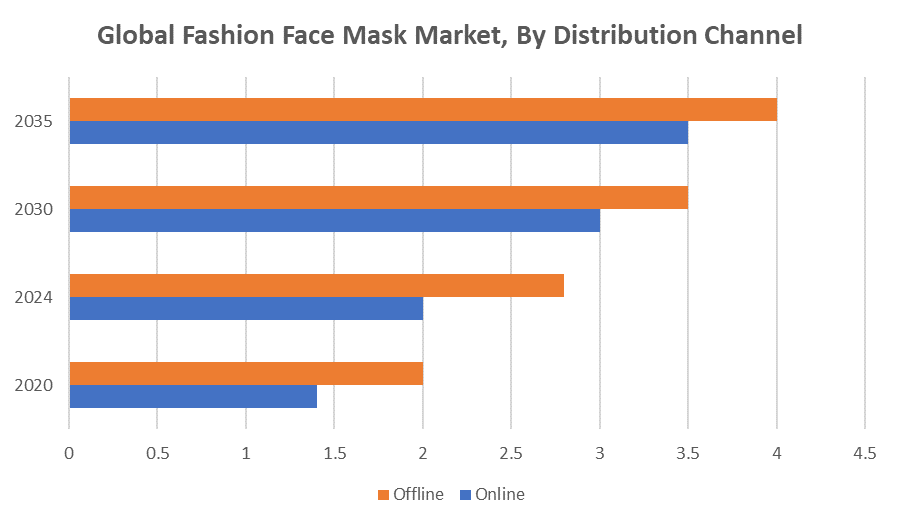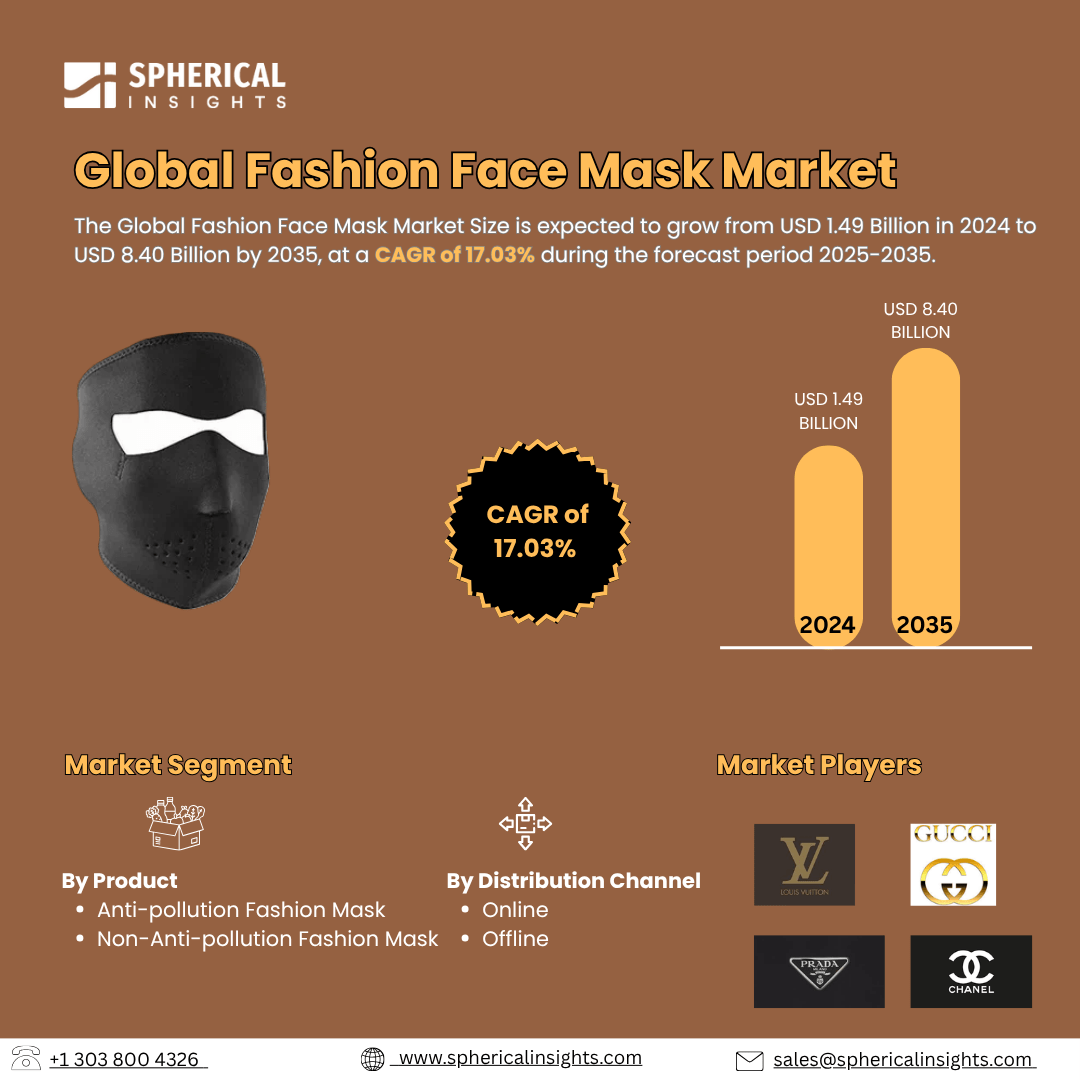Global Fashion Face Mask Market Insights Forecasts to 2035
- The Global Fashion Face Mask Market Size Was Estimated at USD 1.49 Billion in 2024
- The Market Size is Expected to Grow at a CAGR of around 17.03% from 2025 to 2035
- The Worldwide Fashion Face Mask Market Size is Expected to Reach USD 8.40 Billion by 2035
- North America is expected to grow the fastest during the forecast period.

Fashion Face Mask Market
The fashion face mask market encompasses face coverings designed to combine protection with style. These masks are crafted from diverse materials such as cotton, silk, and synthetic fabrics, featuring a wide range of colors, patterns, and designs to suit individual fashion preferences. The market offers various options, from basic reusable masks to luxury designer masks, reflecting growing consumer demand for personalization and sustainability. Fashion masks often prioritize comfort and breathability while maintaining aesthetic appeal. Since emerging as essential during the pandemic, these masks have transitioned into mainstream fashion accessories worn by people of all ages. The market is segmented into types like anti-pollution and non-anti-pollution masks, offering different functionalities alongside style. Washable and reusable masks are increasingly popular, aligning with environmentally conscious consumer trends. Overall, the fashion face mask market continues to grow by merging practicality with visual appeal, becoming a staple in everyday wardrobes beyond their initial protective role.
Attractive Opportunities in the Fashion Face Mask Market
- Fashion brands partnering with tech firms can create innovative face masks that go beyond aesthetics. Features like built-in air filters, sensors for air quality, or voice amplification can turn masks into high-tech accessories. These products appeal to health-conscious, tech-savvy consumers looking for added value. Such collaborations can also enhance brand image and tap into premium market segments. With rising urban pollution and smart wearables trending, this is a promising niche.
- Offering customizable fashion masks allows consumers to express their individuality with unique prints, slogans, or brand logos. Personalization increases customer engagement, loyalty, and perceived value, encouraging repeat purchases. It also opens doors for special collections, limited editions, and gift items. Brands can use online tools to let users design their own masks, making the buying experience more interactive. This trend aligns with broader shifts toward self-expression in fashion.
Global Fashion Face Mask Market Dynamics
DRIVER: Increased health awareness and the ongoing need for protection
Increased health awareness and the ongoing need for protection against airborne diseases have made face masks a daily essential. Alongside this, the rising demand for personalized and stylish products has pushed manufacturers to innovate designs that appeal to consumers’ fashion sensibilities. Social media and celebrity endorsements have significantly influenced consumer behavior, turning face masks into trendy accessories. Additionally, the shift towards reusable and sustainable products has encouraged the production of eco-friendly masks, aligning with growing environmental concerns. The convenience of online shopping has also expanded accessibility, allowing consumers to explore a wide variety of fashionable mask options. Furthermore, regulations and mandates in various countries continue to support mask usage in public spaces, sustaining demand. Together, these factors have propelled the fashion face mask market’s rapid expansion as masks blend health safety with personal style.
RESTRAINT: Concerns about comfort, breathability, and skin irritation
One major challenge is the fluctuating demand as COVID-19 restrictions ease globally, reducing the urgency for mask usage and leading some consumers to abandon them altogether. Additionally, concerns about comfort, breathability, and skin irritation discourage prolonged mask use, especially with certain materials. The market also grapples with issues of counterfeit or low-quality products, which can damage consumer trust and brand reputation. High competition and price sensitivity, particularly in developing regions, pose challenges for premium and designer mask manufacturers. Moreover, the environmental impact of disposable masks has raised awareness about waste, pushing consumers to seek alternatives and potentially slowing demand for single-use fashion masks. Lastly, changing regulations and inconsistent mask mandates worldwide create uncertainty for manufacturers and retailers, impacting production planning and market stability. These factors collectively restrain the pace of growth in the fashion face mask market.
OPPORTUNITY: Collaborations between fashion brands and tech companies
Collaborations between fashion brands and tech companies can create unique, high-value products that attract tech-savvy consumers. Another opportunity lies in expanding customization options, allowing consumers to design masks with personalized prints, logos, or messages, enhancing user engagement. The growing trend of sustainable fashion opens doors for brands to develop masks from organic, recycled, or biodegradable materials, appealing to eco-conscious buyers. Additionally, the increasing focus on corporate branding offers potential for bulk orders of branded masks by businesses aiming to promote their identity while ensuring employee safety. Finally, emerging markets with rising urbanization and pollution concerns represent untapped potential for fashion masks that combine style with protective functionality. These opportunities can help the market evolve and diversify its offerings.
CHALLENGES: Consumer interest as masks become a long-term accessory rather than a temporary necessity
One significant challenge is maintaining consumer interest as masks become a long-term accessory rather than a temporary necessity; keeping designs fresh and relevant requires continuous innovation and investment. Supply chain disruptions, including shortages of quality fabrics and materials, can delay production and increase costs, affecting market stability. Additionally, balancing fashion with safety standards is complex-masks must meet regulatory requirements without compromising style or comfort, which can limit design options. Counterfeit products and intellectual property infringement also pose challenges, undermining brand trust and profitability. Marketing masks effectively to diverse demographics with varying cultural attitudes toward mask-wearing, adding complexity to market penetration. Lastly, managing environmental concerns related to mask disposal demands the development of eco-friendly alternatives, which may involve higher production costs. These challenges require strategic approaches for sustainable growth in the evolving fashion face mask market.
Global Fashion Face Mask Market Ecosystem Analysis
The global fashion face mask market ecosystem includes manufacturers and designers who create diverse styles using various materials, supported by suppliers providing raw fabrics and filters. Retailers and e-commerce platforms distribute masks to a wide consumer base, ranging from fashion enthusiasts to corporate clients. Technology providers contribute innovations like smart masks, while regulatory bodies ensure safety and quality standards. Marketing agencies boost visibility through social media and influencer campaigns. Together, these players form a dynamic network driving market growth and innovation worldwide.
Based on the product, the anti-pollution fashion mask segment dominated the global fashion face mask industry with a revenue share over the forecast period

The anti-pollution fashion mask segment dominated the global fashion face mask industry, maintaining a significant revenue share throughout the forecast period. This dominance is attributed to increasing concerns over air quality and rising pollution levels in urban areas, driving demand for masks that offer both protection and style. Consumers prefer masks that combine effective filtration with fashionable designs, making anti-pollution masks a popular choice across various demographics. The segment’s strong market presence highlights the growing intersection of health awareness and fashion in face mask adoption.
Based on the distribution channel, the offline distribution channel segment held the largest revenue share of the global fashion face mask industry during the forecast period

Physical retail stores, including fashion boutiques, pharmacies, and supermarkets, remained key points of sale due to consumers’ preference for trying masks in person before purchase. Additionally, offline channels provide immediate availability and personalized shopping experiences, which continue to attract a significant customer base. Despite the growth of e-commerce, the offline segment’s established presence and consumer trust helped it maintain its leading position in the market.
Asia Pacific is anticipated to hold the largest market share of the fashion face mask market during the forecast period
Asia Pacific is anticipated to hold the largest market share of the fashion face mask market during the forecast period. This region’s dominance is driven by high population density, widespread urbanization, and increasing awareness of air pollution and health safety. Cultural acceptance of mask-wearing, combined with strong manufacturing capabilities and a growing fashion industry, further fuels market growth. Additionally, rising disposable incomes and expanding e-commerce platforms in countries like China, India, and Japan contribute to increased demand for fashionable and functional face masks across the region.
North America is expected to grow at the fastest CAGR in the fashion face mask market during the forecast period
North America is expected to grow at the fastest CAGR in the fashion face mask market during the forecast period. This growth is driven by increasing consumer demand for stylish, functional, and health-conscious masks, along with heightened awareness of personal hygiene and pollution. The region’s fashion-forward consumers, strong e-commerce infrastructure, social media influence, and celebrity endorsements further contribute to the rapid expansion of the market. North America’s significant share in the global fashion face mask industry highlights its important role in shaping market trends and driving overall growth.
Key Market Players
KEY PLAYERS IN THE FASHION FACE MASK MARKET INCLUDE
- Louis Vuitton
- Gucci
- Prada
- Chanel
- Burberry
- Versace
- Balenciaga
- Off-White
- Supreme
- Ralph Lauren
- Tommy Hilfiger
- Others
Market Segment
This study forecasts revenue at global, regional, and country levels from 2020 to 2035. Spherical Insights has segmented the fashion face mask market based on the below-mentioned segments:
Global Fashion Face Mask Market, By Product
- Anti-pollution Fashion Mask
- Non-Anti-pollution Fashion Mask
Global Fashion Face Mask Market, By Distribution Channel
Global Fashion Face Mask Market, By Regional Analysis
- North America
- Europe
- Germany
- UK
- France
- Italy
- Spain
- Russia
- Rest of Europe
- Asia Pacific
- China
- Japan
- India
- South Korea
- Australia
- Rest of Asia Pacific
- South America
- Brazil
- Argentina
- Rest of South America
- Middle East & Africa
- UAE
- Saudi Arabia
- Qatar
- South Africa
- Rest of the Middle East & Africa






